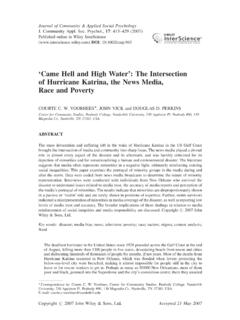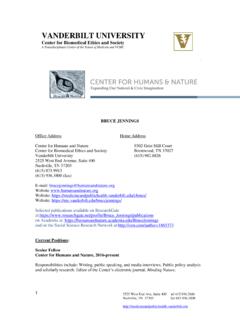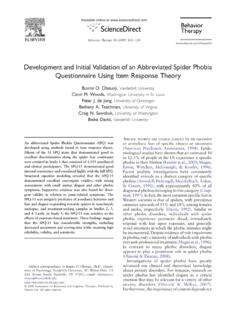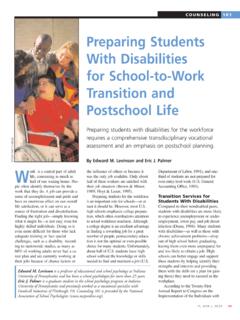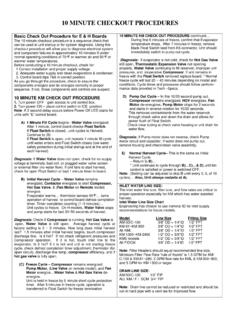Transcription of Tip Sheet: Check-In / Check-Out (CICO) - my.vanderbilt.edu
1 1 Tip sheet : Check-In / Check-Out (CICO) Definition A targeted intervention that can be used to decrease chronic, low-level behaviors that are not dangerous. Check-In / Check-Out is most effective with students who are reinforced by adult attention. It is based on idea of behavior report cards. Components of CICO include: o Increased prompts for appropriate behavior o Increased adult feedback o Increased daily structure for students o Increased feedback to families about their child s behavior. (Filter et al., 2007; Kerr & Nelson, 2010) Other Terminology There are multiple programs that use the basic Check-In / Check-Out processes. For example: See Hawken (2009) : Behavior Education Program (BEP) Daily Progress Report Kennedy Card Program Hello, Update, & Goodbye (HUG program) o HAWK Program (Helping A Winning Kid) ROAR Program (Reinforcement of Appropriate Responses) Rationale IDEA (1997, 2004) has mandated behavioral practices that are proactive and positive.
2 Positive Behavior Support (PBS) is a tiered model designed to support the multiple and varied needs of students with and without disabilities. For students who do not respond well to Tier 1 ( , universal or primary), schools can select from a range of targeted Tier 2 interventions to prevent the further escalation of problem behavior (Kerr & Nelson, 2010). Implementation (Filter et al., 2007) Involves a daily routine where the student: o Checks in each morning with a designated adult to develop daily behavioral goals o Carries a point card throughout the day where adults provide behavioral feedback regarding the goals o Returns to the designated adult at the end of the day to review feedback and calculate points earned for the day o Gives the point card to a parent after school parent signs for student to return the card to school Steps (Kerr & Nelson, 2010) 1.
3 Establish a targeted intervention team who determine how the school will implement the CICO: a. Who will be the designated person to meet with students before and after school ( , guidance counselor)? b. Where will students meet with the designated person? c. How will students be monitored ( , daily point cards and office referrals)? 2 d. How will the students receive recognition for improvement ( , what is the process for exchanging points for back up reinforcers?) e. What are the resources needed to implement this intervention ( , planning time, funds for reinforcers, data entry/analysis)? 2. Develop daily report card to include (see below for example): a. Schoolwide expectations/rules b. Monitoring intervals that include periods or class activities c. Rating scales for teachers to use to evaluate during each time period d.
4 Place to record total daily points e. Place for teachers to write positive comments 3. Train school staff and identified students. 4. Meet weekly to review data and implementation. Decide next steps for targeted students ( , continue, modify, fade, stop). 5. Provide quarterly updates to entire school. Student Steps (Kerr & Nelson, 2010) 1. check in and pick up daily behavior card. 2. At the end of class, ask teacher for feedback and to fill in the card. 3. check out at the end of the day and receive reward if daily goal is met. 4. Take report card home to get parent feedback and get card signed. 5. Return signed card next morning when checking in. Considerations (Myers et al., 2010) 1. Maintain consistency a. As much as possible, have the same designated adult greet the student(s) each morning b.
5 Use checklists of implementation steps to make sure the program is implemented consistently 2. Make sure that the CICO program is a school priority to ensure consistent implementation. 3. Decide how data will be collected and analyzed: Some schools use the SWIS program ( ) 4. Watch for students who are losing interest in the program a. Incorporate self-monitoring b. Schedule booster student training sessions 5. Implement strategies to prevent students from hoarding tokens a. Involve students in the selection of back up reinforcers b. Schedule have to pay to participate events ( , pizza parties) c. Incorporate expiration dates for tokens See sample CICO form below. Evidence Used in general and special education settings (Todd et al., 2008) Effective in reducing classroom disruptions in elementary (Fairbanks et al.)
6 , 2005; Meyer et al., 2008) and middle school (Hawken & Horner, 2003) Effective in decreasing office referrals (Filter et al., 2007) Effective with behaviors maintained by teacher attention (March & Horner, 2002) Not as effective for students who are not motivated by attention but who are motivated by escape (March & Horner, 2002) 3 Note: These citations do not represent a comprehensive literature review but only a sample of evidence to support the use of this strategy. 4 Daily Point Total _____ / 84 = _____ X 100 = _____ (Daily Point Percentage) School Name: Positive Behavior Support Expectations Name: _____ Today s Goal:_____ Date:_____ Student Signature:_____ Expectations 1st Period 2nd Period 3rd Period 4th Period 5th Period 6th Period 7th Period 1) 2 1 0 2 1 0 2 1 0 2 1 0 2 1 0 2 1 0 2 1 0 2) 2 1 0 2 1 0 2 1 0 2 1 0 2 1 0 2 1 0 2 1 0 3) 2 1 0 2 1 0 2 1 0 2 1 0 2 1 0 2 1 0 2 1 0 4) 2 1 0 2 1 0 2 1 0 2 1 0 2 1 0 2 1 0 2 1 0 5) 2 1 0 2 1 0 2 1 0 2 1 0 2 1 0 2 1 0 2 1 0 Work Completion 2 1 0 2 1 0 2 1 0 2 1 0 2 1 0 2 1 0 2 1 0 Total Teacher Initials Student Initials WOW!
7 (Please comment on successes here.) Parent Signature:_____ Parent Wows!:_____ _____ check In Pen/Pencil Paper Agenda Parent Signature Mentor Initials check Out Form Copied % Calculated Homework Mentor Initials Key: 0 = Did not meet expectation at all; 1= Partially met expectation; 2= Always met expectation 5 References Alberto, P. A., & Troutman, A. C. (2009). Applied behavior analysis for teachers (8th ed.). Upper Saddle River, NJ: Pearson Education, Inc. Fairbanks, S., Sugai, G., Guardino, D., & Lathrop, M. (2005). An evaluation of a collaborative social behavior response to intervention system of behavior support for second grade students. Exceptional Children, 40(6), 44-52. Filter, K. J., et al., (2007). check in / check out: A post hoc evaluation of an efficient, secondary-level targeted intervention for reducing problem behaviors in schools.
8 Education and Treatment of Children, 30(1), 69-84. Hawken, L. H., & Homer, R. H. (2003). Evaluation of a targeted intervention within a schoolwide system of behavior support. Journal of Behavioral Education, 12 (3), 225-240. Kerr, M. M., & Nelson, C. M. (2010). Strategies for addressing behavior problems in the classroom (6th ed.). Boston, MA: Pearson. March, R. E., & Horner, R. H. (2002). Feasibility and contribution of functional behavioral assessment in the schools. Journal of Emotional and Behavioral Disorders, 10 (3), 158-170. Myers, B. M., Briere, D. E., & Simonsen, B. (2010). Lessons learned from implementing a check - in/ Check-Out behavioral program in an urban middle school. Beyond Behavior, 19(2), 21-27. Todd, A. W., Campbell, A. L., Meyer, G. B., & Horner, R. H. (2008).
9 The effects of a targeted intervention to reduce problem behaviors. Journal of Positive Behavior Intervention, 10(1), 46-55.

